JENN-AIR JES8750AAB, JES8750AAW, JES8850AAB, JES8850AAQ, JES8850AAS Owner's Manual
...
JENN-AIR ELECTRIC SLIDE-IN RANGE
USER
G U I D E
TABLE OF CONTENTS |
|
Safety Instructions ................................................................... |
1-3 |
Surface Cooking ....................................................................... |
4-5 |
Oven Cooking ........................................................................ |
6-13 |
Care & Cleaning .................................................................. |
14-16 |
Maintenance ............................................................................... |
17 |
Before You Call for Service ................................................... |
18 |
Warranty .................................................................................... |
19 |
Guide de l’utilisateur................................................................ |
20 |
Guía del Usuario ....................................................................... |
40 |
Form No. B/06/02 Part No. 8113P367-60 74005524 © 2002 Maytag Appliances Sales Co. Litho U.S.A .
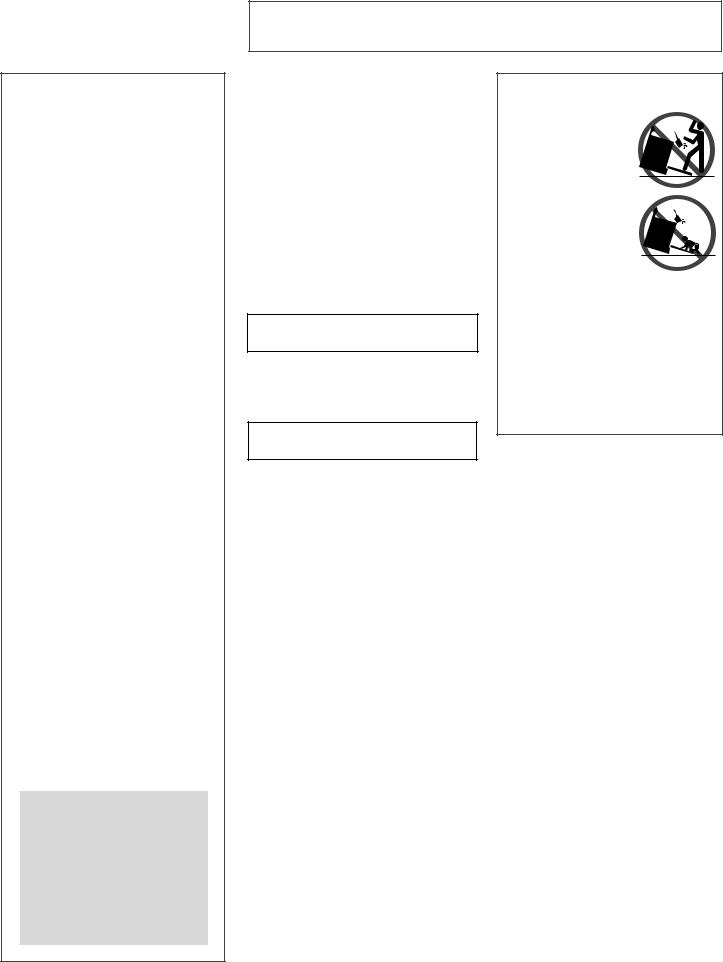
Installer: Please leave this manual with this appliance.
Consumer: Please read and keep this manual for future reference. Keep sales receipt and/or cancelled check as proof of purchase.
Model Number
–– –– –– –– –– –– –– –– ––
Serial Number
–– –– –– –– –– –– –– –– ––
Date of Purchase
_______________________________
If you have questions, call:
Jenn-Air Customer Assistance
1-800-688-1100
1-800-688-2080 ( U.S. TTY for hearing or speech impaired)
(Mon.-Fri., 8 am-8 pm Eastern Time)
Internet: http://www.jennair.com
For service information, see page 19.
In our continuing effort to improve the quality and performance of our cooking products, it may be necessary to make changes to the appliance without revising this guide.
IMPORTANT SAFETY INSTRUCTIONS
SAFETY INSTRUCTIONS
Warning and Important Safety Instructions appearing in this guide are not meant to cover all possible conditions and situations that may occur. Common sense, caution, and care must be exercised when installing, maintaining, or operating the appliance.
Always contact your dealer, distributor, service agent, or manufacturer about problems or conditions you do not understand.
RECOGNIZE SAFETY SYMBOLS, WORDS, LABELS
 WARNING
WARNING
WARNING – Hazards or unsafe practices which COULD result in severe personal injury or death.
 CAUTION
CAUTION
CAUTION – Hazards or unsafe practices which COULD result in minor personal injury.
Read and follow all instructions before using this appliance to prevent the potential risk of fire, electric shock, personal injury or damage to the appliance as a result of improper usage of the appliance. Use appliance only for its intended purpose as described in this guide.
To ensure proper and safe operation:
Appliance must be properly installed and grounded by a qualified technician.
 WARNING:
WARNING:
•ALL RANGES CAN TIP AND CAUSE INJURIES TO PERSONS
•I N S T A L L ANTI-TIP DE-
VICE PACKED
WITH RANGE
•FOLLOW ALL INSTALLATION INSTRUCTIONS
WARNING: To reduce risk of tipping of the appliance from abnormal usage or by excessive loading of the oven door, the appliance must be secure by a properlyinstalledanti-tipdevice.
To check if device is properly installed, look underneath range with a flashlight to make sure one of the rear leveling legs is properly engaged in the bracket slot. The anti-tip device secures the rear leveling leg to the floor when properly engaged. You should check this anytime the range has been moved.
IN CASE OF FIRE
Turn off appliance and ventilating hood to avoid spreading the flame. Extinguish flame then turn on hood to remove smoke and odor.
•Cooktop: Smother fire or flame in a pan with a lid or cookie sheet.
NEVER pick up or move a flaming pan.
•Oven: Smother fire or flame by closing the oven door.
Do not use water on grease fires. Use baking soda, a dry chemical or foam-type extinguisher to smother fire or flame.
1

GENERAL
INSTRUCTIONS
 WARNING
WARNING
NEVER use appliance door, or drawer, if equipped, as a step stool or seat as this may result in possible tipping of the appliance, damage to the appliance, and serious injuries.
If appliance is installed near a window, precautions should be taken to prevent curtains from blowing over surface elements.
NEVER use appliance to warm or heat the room. Failure to follow this instruction can lead to possible burns, injury, fire, or damage to the appliance.
NEVER wear loose-fitting or hanging garments while using the appliance. Clothing could catch utensil handles or ignite and cause burns if garment comes in contact with hot heating elements.
To ensure proper operation and to avoid damage to the appliance or possible injury, do not adjust, service, repair or replace any part of the appliance unless specifically recommended in this guide. Refer all other servicing to a qualified technician.
NEVER store or use gasoline or other combustible or flammable materials in the oven, near surface units or in the vicinity of this appliance as fumes could create a fire hazard or an explosion.
To prevent grease fires, do not let cooking grease or other flammable materials accumulate in or near the appliance.
Use only dry potholders. Moist or damp potholders on hot surfaces may result in a steam burn. Do not let potholders touch hot heating elements. Do not use a towel or other bulky cloth which could easily touch hot heating elements and ignite.
Always turn off all controls when cooking is completed.
NEVER heat unopened containers on the surface unit or in the oven. Pressure buildup in the container may cause container to burst resulting in burns, injury or damage to the appliance.
This appliance has been tested for safe performance using conventional cookware. Do not use any devices or accessories that are not specifically recommended in this manual. Do not use eyelid covers, stove top grills or add-on oven convection systems. The use of devices or accessories that are not expressly recommended in this manual can create serious safety hazards, result in performance problems, and reduce the life of the components of this appliance.
NEVER use aluminum foil to line drip bowls or cover oven racks or oven bottom. This could result in risk of electric shock, fire, or damage to the appliance. Use foil only as directed in this guide.
Aerosol-type cans are EXPLOSIVE when exposed to heat and may be highly flammable. Do not use or store near appliance,
COOKTOP
NEVER leave surface units unattended especially when using high heat. An unattended boilover could cause smoking and a greasy spillover can cause a fire.
This appliance is equipped with different size surface elements. Select pans with flat bottoms large enough to cover element. Fitting pan size to element will improve cooking efficiency.
If pan is smaller than element, a portion of the element will be exposed to direct contact and could ignite clothing or potholder.
Only certain types of glass, glass/ceramic, ceramic, earthenware, or other glazed utensils are suitable for cooktop or oven service without breaking due to the sudden change in temperature. Follow utensil manufacturer’s instructions when using glass.
Turn pan handle toward center of cooktop, not out into the room or over another surface element. This reduces the risk of
burns, ignition of flammable materials, or spillage if pan is accidently bumped or reached by small children.
GLASS-CERAMIC COOKTOP
NEVER cook on broken cooktop. If cooktop should break, cleaning solutions and spillovers may penetrate the broken cooktop and create a risk of electric shock. Contact a qualified technician immediately.
Clean cooktop with caution. Some cleaners can produce noxious fumes if applied to a hot surface. If a wet sponge, cloth, or paper towel is used on a hot cooking area, be careful to avoid steam burn.
DEEP FAT FRYERS
Use extreme caution when moving the grease pan or disposing of hot grease. Allow grease to cool before attempting to
OVEN
Use care when opening door. Let hot air or steam escape before removing or replacing food.
For proper oven operation and performance, do not block or obstruct oven vent duct. When oven is in use, the vent and surrounding area become hot enough to cause burns.
Always place oven racks in desired locations while oven is cool. If rack must be moved while oven is hot, do not let potholder contact hot element in oven.
SELF-CLEANING OVEN
Clean only parts listed in this guide. Do not clean door gasket. The gasket is essential for a good seal. Do not rub, damage, or move the gasket.
Do not use oven cleaners. No commercial oven cleaner or oven liner protective coating of any kind should be used in or around any part of the oven.
2

IMPORTANT SAFETY INSTRUCTIONS, CONT.
Before self-cleaning the oven, remove broiler pan, oven racks and other utensils to prevent excessive smoking, discoloration of the oven racks or possible damage to utensils.
Wipe up excessive spillovers, especially greasy spills, before the clean cycle to prevent smoking, flare-ups or flaming.
It is normal for the cooktop to become hot during a clean cycle. Therefore, avoid touching the cooktop, door, window or oven vent during a clean cycle.
Slide-in ranges feature a cooling fan which operates automatically during a clean cycle. If the fan does not turn on, cancel the clean operation and contact an authorized servicer.
HEATING ELEMENTS
NEVER touch surface or oven heating elements, areas near elements, or interior surfaces of oven.
Heating elements may be hot even though they are dark in color. Areas near surface elements and interior surfaces of an oven may become hot enough to cause burns.
During and after use, do not touch or let clothing or other flammable materials contact heating elements, areas near elements, or interior surfaces of oven until they have had sufficient time to cool.
Other potentially hot surfaces include: Cooktop, areas facing the cooktop, oven vent, and surfaces near the vent opening, oven door, areas around the door and oven window.
CHILD SAFETY
 CAUTION
CAUTION
NEVER store items of interest to children in cabinets above an appliance or on backguard of a range. Children climbing on the appliance door to reach items could be seriously injured.
NEVER leave children alone or unsupervised in area where appliance is in use or is still hot.
NEVER allow children to sit or stand on any part of the appliance as they could be injured or burned.
Children must be taught that the appliance and utensils in or on it can be hot. Let hot utensils cool in a safe place, out of reach of small children. Children should be taught that an appliance is not a toy. Children should not be allowed to play with controls or other parts of the unit.
VENTILATING HOODS
Clean range hood and filters frequently to prevent grease or other flammable materials from accumulating on hood or filter and to avoid grease fires.
Turn the fan on when flambéing foods (such as Cherries Jubilee) under the hood.
IMPORTANT SAFETY NOTICE AND WARNING
The California Safe Drinking Water and Toxic Enforcement Act of 1986 (Proposition 65) requires the Governor of California to publish a list of substances known to the State of California to cause cancer or reproductive harm, and requires businesses to warn customers of potential exposures to such substances.
Users of this appliance are hereby warned that when the oven is engaged in the selfclean cycle, there may be some low level exposure to some of the listed substances, including carbon monoxide. Exposure to these substances can be minimized by properly venting the oven to the outdoors during the self-clean cycle by opening a window and/or door in the room where the appliance is located.
IMPORTANTNOTICEREGARDING PET BIRDS: Never keep pet birds in the kitchen or in rooms where the fumes from the kitchen could reach. Birds have a very sensitive respiratory system. Fumes released during an oven self-cleaning cycle may be harmful or fatal to birds. Fumes released due to overheated cooking oil, fat, margarine and overheated non-stick cookware may be equally harmful.
SAVE THESE INSTRUCTIONS
FOR FUTURE REFERENCE
3
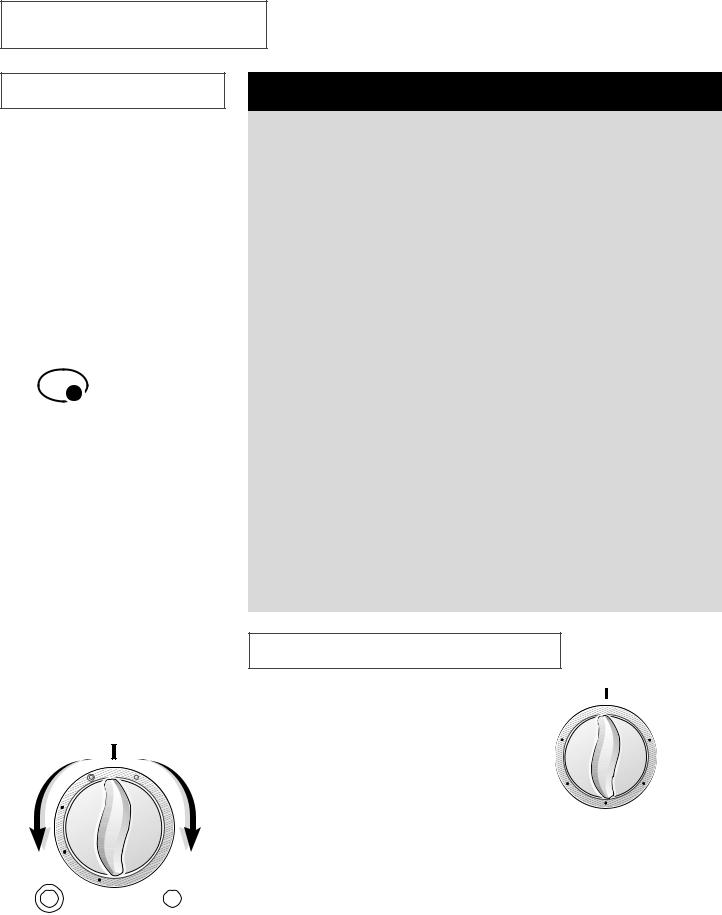
SURFACE COOKING
SURFACE CONTROLS
Use to turn on the surface elements. An infinite choice of heat settings is available from lo to hi. The knobs can be set on or between any of the settings.
SETTING THE
CONTROLS
1.Place pan on surface element.
2.Push in and turn the knob in either direction to the desired heat setting.
•The control panel is marked to identify which element the knob
controls. For example, indicatesright front element.
3.There is an indicator light above each control knob. When a surface control knob is turned on, the light will turn on. The light will turn off when the surface element is turned off.
4.After cooking, turn knob to OFF. Remove pan.
DUAL ELEMENT
The cooking surface is equipped with a dual element located in the right front position. To operate, push in on the control knob and turn to the right to control the large element, or push in and turn to the left to control the small element.
OFF
|
|
h |
|
4 |
i |
|
|
|
|
|
ol |
LARGE |
|
SMALL |
ELEMENT |
|
ELEMENT |
 CAUTION
CAUTION
BEFORE COOKING
•Always place a pan on the surface unit before you turn it on. To prevent damage to range, never operate surface unit without a pan in place.
•NEVER use the cooktop as a storage area for food or cookware.
DURING COOKING
•Be sure you know which knob controls which surface unit. Make sure you turned on the correct surface unit.
•Begin cooking on a higher heat setting then reduce to a lower setting to complete the operation. Never use a high heat setting for extended cooking.
•NEVER allow a pan to boil dry. This could damage the pan and the appliance.
•NEVER touch cooktop until it has cooled. Expect some parts of the cooktop, especially around the surface units, to become warm or hot during cooking. Use potholders to protect hands.
AFTER COOKING
•Make sure surface unit is turned off.
•Clean up messy spills as soon as possible.
OTHER TIPS
•If cabinet storage is provided directly above cooking surface, limit it to items that are infrequently used and can be safely stored in an area subjected to heat.
Temperatures may be unsafe for items such as volatile liquids, cleaners or aerosol sprays.
•NEVERleave any items, especially plastic items, on the cooktop. The hot air from the vent may ignite flammable items, melt or soften plastics, or increase pressure in closed containers causing them to burst.
•NEVER allow aluminum foil, meat probes or any other metal object, other than a pan on a surface element, to contact heating elements.
SUGGESTED HEAT SETTINGS
The size, type of cookware and cooking operation will affect the heat setting. For information on cookware and other factors affecting heat settings, refer to “Cooking Made Simple” booklet.
hi: Use to bring liquid to a boil. Always reduce setting to a lower heat when liquids begin to boil or foods begin to cook.
med. hi: Use to brown meat, heat oil for deep fat frying or sauteing. Maintain fast boil for large amounts of liquids.
medium: Use to maintain slow boil for large amounts of liquids and for most frying operations.
hi |
lo |
|
OFF |
i |
l |
h |
o |
|
|
8 |
2 |
6 |
4 |
med. hi |
med. lo |
medium
med. lo: Use to continue cooking covered foods or steam foods.
lo: Use to keep foods warm and melt chocolate and butter.
4

SURFACE COOKING, CONT.
GLASS-CERAMIC SURFACE
NOTES:
•On Canadian models, some or all of the surface will not operate during a self-clean cycle.
•Cooktop may emit light smoke and odor the first few times the cooktop is used. This is normal.
•When a control is turned on, a red glow can be seen through the glass-ceramic surface. The element will cycle on and off to maintain the preset heat setting.
•Glass-ceramic cooktops retain heat for a period of time after the unit is turned off. When the HOT SURFACE light turns off (see below), the cooking area will be cool enough to touch.
•NOTE: Do not attempt to lift the cooktop.
COOKING AREAS
The cooking areas on your range are identified by permanent patterns on the glassceramic surface. For most efficient cooking, fit the pan size to the element size.
Pans should not extend more than 1/2 to 1- inch beyond the cooking area.
For more information on cookware, refer to
“Cooking Made Simple” booklet.
HOT SURFACE LIGHTS
Each element has a HOT SURFACE indicator light. A light will be illuminated when the matching cooking area is hot. It will remain on, even after the control is turned off, until the area has cooled. They are located adjacent to each element.
TIPS TO PROTECT THE
GLASS-CERAMIC SUR-
FACE
•Before first use, clean the cooktop. (See Cleaning, page 15.)
•Do not use glass pans. They may scratch the surface.
•Do not allow plastic, sugar or foods with high sugar content to melt onto the hot cooktop. Should this happen, clean immediately. (See Cleaning, page 15.)
•Never let a pan boil dry as this will damage the surface and pan.
•Never use cooktop as a work surface or cutting board. Never cook food directly on the surface.
•Never place a trivet or wok ring between the surface and pan. These items can mark or etch the top.
•Do not slide aluminum pans across a hot surface. The pans may leave marks which need to be removed promptly. (See Cleaning, page 15.)
•Make sure the surface and the pan bottom are clean before turning on to prevent scratches.
•To prevent scratching or damage to the glass-ceramic top, do not leave sugar, salt or fats on the cooking area. Wipe the cooktop surface with a clean cloth or paper towel before using.
•Never use a soiled dish cloth or sponge to clean the cooktop surface. A film will remain which may cause stains on the cooking surface after the area is heated.
•Do not use a small pan on a large element. Not only does this waste energy, but it can also result in spillovers burning onto the cooking area which requires extra cleaning
5
•Do not use non-flat specialty items that are oversized or uneven such as round bottom woks, rippled bottom and/or oversized canners and griddles.
•Do not slide heavy metal pans across the surface since these may scratch.
•Do not use foil or foil-type containers. Foil may melt onto the glass. If metal melts on the cooktop, do not use. Call an authorized Jenn-Air Servicer.
•If a spillover occurs while cooking, immediately clean the spill from the cooking area while it is hot to prevent a tough cleaning chore later. Using extreme care, wipe spill with a clean dry towel.
•Do not allow spills to remain on the cooking area or the cooktop trim for a long period of time.
•Do not use abrasive cleansing powders or scouring pads which will scratch the cooktop.
•Do not use chlorine bleach, ammonia or other cleansers not specifically recommended for use on glass-ceramic.
•To retain the appearance of the glassceramic cooktop, clean after each use.
NOTES:
•Glass ceramic surfaces retain heat. Turn the elements off a few minutes before food is completely cooked and use the retained heat to complete the cooking.
Because of the heat retention characteristics, the elements will not respond to changes in settings as quickly as coil elements. In the event of a potential boilover, remove the pan from the cooking area.
COOKWARE
To achieve optimum cooking performance, use heavy-gauge, flat, smooth bottom pans that conform to the diameter of the cooking area. ( See “Cooking Made Simple” for cookware characteristics and recommendations.)
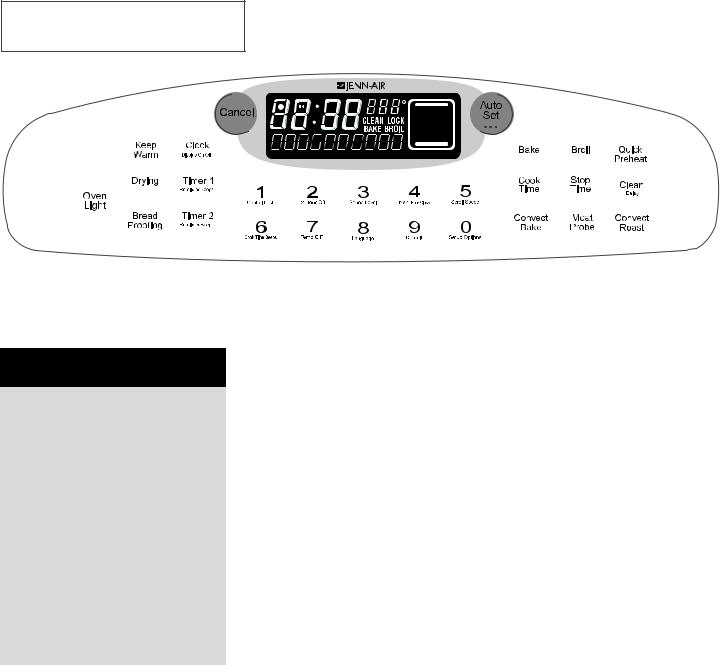
OVEN COOKING
The electronic control is designed for ease in programming. The display window on the control shows time of day, timer and oven functions. Control panel shown includes Convect and other model specific features. (Styling may vary depending on model.)
 CAUTION
CAUTION
•Be sure all packing material is removed from oven before turning on.
•Prepared Food Warning: Follow food manufacturer’s instructions. If a plastic frozen food container and/or its cover distorts, warps, or is otherwise damaged during cooking, immediately discard the food and its container. The food could be contaminated.
•Follow the manufacturer’s directions when using oven cooking bags.
•Do not use oven for storing food or cookware.
CONTROL PAD
OPERATION
•Press the desired function pad.
•Press the Auto Set pad or the appropriate number pad(s) to enter time or temperature.
•A beep will sound when any pad is pressed.
•A double beep will sound if a programming error occurs.
•Further instructions will scroll in display after function pads are pressed.
NOTE: The temperature or time will be automatically entered four seconds after selection.
If more than 30 seconds elapse between pressing a function pad and the Auto Set pad or number pads, the function will be canceled and the display will return to the previous display.
CONTROL OPTIONS
Several control options are indicated under the number pads on the control. Factoryset options can be changed to your preferences. See page 12 for more information.
SETTING CONTROL
FUNCTIONS
CLOCK PAD
1.Press Clock pad. Indicator word TIME will flash in the display.
2.Press the appropriate number pads for the current time.
After a power interruption, POWER INTERRUPTION will scroll followed by SET CLOCK.
To recall the time of day when another function is showing, press Clock pad.
Clock time cannot be changed when the oven has been programmed for clock controlled cooking, self-clean or delayed selfclean.
The clock may be set to a 24-hour clock. See Control Options (12/24 Hour Clock), page 12.
TIMER PADS
The timer(s) may be set for any time period up to 99 hours and 59 minutes (99:59).
The timer(s) operates independently of any other function and can be set while another oven function is operating. THE TIMER
DOES NOT CONTROL THE OVEN.
1.Press the Timer 1 or 2 pad. TIMER 1 or 2 will flash respectively. 0HR:00 will appear in the display.
2.Press the appropriate number pads to enter desired time.
3.TIMER 1 or TIMER 2 will be displayed. If both timers are active, the Timer with the least amount of time left will be displayed.
EXAMPLE: To set a timer for 5 minutes, press the Timer 1 pad and the number pad 5. The control will begin countdown after a four second delay.
4.The last minute of the countdown will be displayed in seconds.
6

OVEN COOKING, CONT.
5.At the end of the set time, “END” will be displayed and two chimes will sound followed by two chimes every 30 seconds for up to five minutes. Press the corresponding Timer pad to cancel the chimes.
NOTE: The Timer reminder chimes at the end of a set time may be changed. See Control Options (End-of-Timer Signal), page 12.
To Cancel a Set Time:
Press and hold the corresponding Timer pad for several seconds. After a slight delay the time of day will appear.
OR
Press the Timer pad and the “0” number pad. After a slight delay the timer will be canceled.
CANCEL PAD
Use to cancel all programming except the Clock and Timer functions.
BAKE PAD
Use for baking and roasting.
1.Press Bake pad.
2.Press again for 350° F or press the Auto
Set pad. Each additional press of Auto Set will raise the temperature 25° F. Or,
press the appropriate number pads for the desired temperature between 100° F and 550° F.
3.When the oven turns on, a red preheat indicator will light and the bake icon will
be displayed.
PREHEAT
INDICATOR
4.A single chime will indicate the oven is preheated to the set temperature. The preheat indicator will turn off.
5.When cooking is complete, press Cancel pad. Remove food from oven.
CONVECT BAKE PAD/
CONVECT ROAST PAD
(SELECT MODELS)
1.PressConvectBakeorConvectRoast pad.
2.Press again for 325° F or press the Auto
Set pad. Each additional press of Auto Set will raise the temperature 25° F. Or,
press the appropriate number pads for the desired temperature between 100° F and 550° F.
3.When the oven turns on, a red preheat indicator will light and the convect
icon will be displayed.
4.A single chime will indicate the oven is preheated to the set temperature. The preheat indicator will turn off.
5.When cooking is complete, press Cancel pad. Remove food from oven.
AUTO SET PAD
Use with function pads to automatically set:
•350° F bake temperature
•325° F convect bake or roast temperature (select models)
•hi or lo broil
•three hours of cleaning time
•140° F drying temperature (select models)
•160° F probe temperature (select models)
•170° F keep warm temperature (select models)
•quick or standard bread proofing (select models)
•to change control options
NOTES:
BAKING |
• As a general rule, when convec- |
|||
• |
To recall the set temperature during |
tion baking, set the oven tempera- |
||
ture 25° F lower than the conven- |
||||
|
preheat press the Bake pad. |
tional recipe or prepared mix di- |
||
|
|
|||
• To change oven temperature during |
rections. Baking time will be the |
|||
|
cooking, press the Bake pad and the |
same to a few minutes less than |
||
|
appropriate number pads. |
directions. |
|
|
• |
Allow 10-12 minutes for the oven to |
Convect Roast function cycles both |
||
|
preheat. |
the bake and broil elements along with |
||
• Do not use temperatures below 140° F |
the convection fan at a high speed. |
|||
|
to keep food warm or below 200° F for |
• Whenroastingmeatusingthecon- |
||
|
cooking. For food safety reasons, lower |
vectionsetting,roastingtimesmay |
||
|
temperatures are not recommended. |
be up to 30% less. (Use conventional |
||
• For additional baking and roasting tips, |
roasting temperatures.) |
|||
• See roasting chart in “Cooking Made |
||||
|
refer to the “CookingMadeSimple” |
|||
|
booklet. |
Simple” booklet for |
recommended |
|
CONVECT BAKING AND |
roasting temperature |
and times, and |
||
additional baking and convection cook- |
||||
ROASTING (select models) |
||||
ing tips. |
|
|||
• |
Convect Bake function cycles both |
|
||
• The convection fan will stop when- |
||||
|
the bake and broil elements along with |
|||
|
the convection fan at a low speed. |
ever the oven door is opened. |
||
|
|
|
||
7

BROIL PAD
Use for top browning or broiling. For best results, use the broiler pan provided with your range.
1.Press the Broil pad.
2.Press the Auto Set pad for hi broil, press again for lo broil, or press the
appropriate number pads to set desired broil temperature between 300° and 550° F.
3.For optimal broiling, preheat three to four minutes or until the broil element is red.
4.Place food in oven leaving the oven door open to the first stop position (about four inches).
5.Follow broiling recommendations in
“Cooking Made Simple” booklet.
6.When broiling is complete, press Cancel pad. Remove food and broiler pan from oven.
COOK TIME/STOP TIME
PADS (CLOCK CONTROLLED
OVEN COOKING)
Use to program the oven to start and stop automatically. Cook time may be set for up to 11 hours and 59 minutes (11:59). The clock must be functioning and correctly set for this feature to work.
TO START IMMEDIATELY AND TURN OFF AUTOMATICALLY:
1.Press Cook Time pad. COOK TIME will flash. Press the appropriate number pads to enter cooking time in hours and minutes.
2.Press the Bake or Convect Bake or
Convect Roast (select models) pad and select the temperature. COOK TIME will be displayed along with the temperature.
3.One minute before the end of the programmed cook time, the oven light will turn on. The light will turn off automati-
cally when Cancel pad is pressed or after oven door is opened and closed.
4.At the end of cook time, the oven will shut off automatically, "End" and COOK TIME will be displayed and three chimes will sound.
5.Press Cancel pad. Remove food from oven. If the program is not canceled, there will be two reminder chimes every minute for up to 30 minutes.
NOTE: The Cook Time/Stop Time reminder chimes may be changed. See Control Options (End-of-Cook-Time Signal), page 12.
4.Press Stop Time pad again. STOP
TIME must be flashing to set the delay start time.
5.Press the appropriate number pads to enter the time you want the oven to stop.
6.DELAY will be displayed.
7.At the end of the delay period, BAKE and COOK TIME will be displayed along with the temperature.
8.Follow steps 3-5 in preceding section.
QUICK PREHEAT PAD (SELECT
MODELS)
TO DELAY THE START OF COOKING AND TURN OFF AUTOMATICALLY:
1.Press Cook Time pad. COOK TIME will flash. Press the appropriate number pads to enter cooking time in hours and minutes.
2.Press the Bake or Convect Bake or
Convect Roast (select models) pad and select the temperature. COOK TIME will be displayed along with the temperature.
3.Press Stop Time pad. Display shows when the oven will stop based on an immediate start.
Use to decrease preheating time when using the Bake or Convect Bake pad. Use for all foods when baking on one rack.
•Press the Bake or Convect Bake pad and select the temperature.
•Press the Quick Preheat pad. QUICK PREHEAT - 1 RACK BAKING will scroll twice and then PREHEATING will be displayed.
TO RETURN TO STANDARD PREHEAT:
•Press Quick Preheat pad again. This will provide standard preheat and the display will scroll STANDARD PREHEAT.
NOTES:
BROILING
•Hi broil is used for most broiling. Use lo broil when broiling longer cooking foods to allow them to cook to well done stage without excessive browning.
•A cooling fan will automatically turn on during broiling. If it does not operate, contact an authorized servicer.
•Never cover broiler pan insert with aluminum foil. This prevents fat from draining to the pan below.
•Expect broil times to be longer and browning to be slightly lighter if appliance is installed on a 208 volt circuit.
CLOCK CONTROLLED OVEN COOKING
•Highly perishable foods such as dairy products, pork, poultry or seafood are not recommended for delayed cooking.
•Clock controlled baking is not recommended for baked items that require a preheated oven, such as cakes, cookies and breads.
8

OVEN COOKING, CONT.
KEEP WARM PAD (SELECT MODELS)
For safely keeping foods warm or for warming breads and plates.
1.Press Keep Warm pad.
2.Press Auto Set pad for 170° F or press
the appropriate number pads for temperatures between 145° and 190° F.
3.KEEP WARM and the temperature selected will be displayed when the function is active.
4.When warming is complete, press Cancel pad. Remove food from the oven.
MEAT PROBE PAD (SELECT MODELS)
To roast and bake items to the desired temperature without over or under cooking.
1.Insert the probe into the food item. (For meats, the probe tip should be located in the center of the thickest part of the meat and not into the fat or touching a bone.)
2.Insert the probe plug into the receptacle located on the top right of the oven. Be certain to insert plug into the receptacle all the way. The control will read PRESS PROBE PAD.
3.Press Probe Pad.
4.Set the desired internal temperature of
the food by pressing Auto Set pad for 160° F or press the appropriate number pads for temperature between 100° and 185° F.
5.Press the Bake, Convect Bake, or
Convect Roast pad. Press the appro-
priate number pads for the desired temperature between 100° and 550° F.
6.When the probe has reached the set temperature, the oven will shut off, “END” will be displayed and four chimes will sound followed by one chime every minute for one hour or until the Cancel pad is pressed.
BREAD PROOFING PAD
(SELECT MODELS)
For proofing or allowing yeast bread products to rise prior to baking. There are two proofing methods available – STANDARD and QUICK.
Standard Proofing temperature is slightly higher than room temperature, protecting dough from temperature changes and drafts that can affect proofing results.
Quick Proofing provides faster results than countertop or standard proofing, without harming the yeast.
1.Press Bread Proofing pad.
2.Press the Auto Set pad for Standard Proof, press again for Quick Proof.
3.When proofing is complete, press the
Cancel pad.
NOTES:
QUICK PREHEAT
•For optimum baking and browning results, Quick Preheat is not recommended when baking on multiple racks.
•For best results, use rack position 2 or 3 when using the Quick Preheat option.
-use only oven-safe plates, check with the manufacturer.
-do not set warm dishes on a cold surface as rapid temperature changes could cause crazing.
MEAT PROBE
KEEP WARM
•For optimal food quality and nutrition, oven cooked foods should be kept warm for no longer than 1 to 2 hours.
•For optimal food quality and color, foods cooked on the range top should be kept warm for an hour or less.
•To keep foods from drying, cover loosely with foil or a lid.
•TO WARM DINNER ROLLS:
-cover rolls loosely with foil and place in oven.
-press Keep Warm and Auto Set pads.
-warm for 12-15 minutes.
•TO WARM PLATES:
-place 2 stacks of up to four plates each in the oven.
-press Keep Warm and Auto Set pads.
-warm for five minutes, turn off the oven and leave plates in the oven for 15 minutes more.
•The probe must be removed from the oven when it is not being used.
•Because of the excellent insulation of the oven, the retained heat continues to cook the food after the signal has sounded and the oven has cycled off. For this reason it is important to remove the food from the oven as soon as the signal sounds.
•Use the handle of the probe for inserting and removing. Do not pull on the cable.
Use a potholder to remove since probe becomes hot.
•For frozen meats, insert probe after 1-2 hours of roasting.
•To clean cooled probe, wipe with a soapy dishcloth. Do not submerge probe in water or wash in the dishwasher.
BREAD PROOFING
•For any dough that requires one rise, either Standard or Quick Proofing can be used.
•For dough requiring two rises, Standard Proofing must be used for the first rising period. Either Standard or Quick Proofing can be used for the second rise.
9

DRYING PAD
(SELECT MODELS)
For drying fruits, vegetables, herbs, etc. Use a drying rack for best results. It allows air to circulate evenly around the foods.
1.Press the Drying pad.
2.Press the Auto Set pad for 140° F or press the appropriate number pads for
the desired drying temperature between 100° and 200° F.
3.The oven door needs to be opened slightly to allow moisture to escape from the oven during the drying process.
•Open the oven door slightly.
•Place the magnetic door spacer (Part No. 8010P146-60) over the plunger
switch at the
upper right side of the oven frame.
The spacer provides a gap between the
oven frame and the oven door allowing moisture to escape.
•Gently close the door until the spacer magnet makes contact with the oven door. The magnet will hold the spacer in the proper position during the drying process and allows the door to be opened at any time during drying without losing proper positioning.
NOTES:
DRYING |
|
||
• |
To purchase a drying rack, contact |
• Fruits that turn brown when exposed |
|
|
your Jenn-Air dealer for the |
to air should be treated with an antioxi- |
|
|
“DRYINGRACK” Accessory Kit or |
dant. Try one of the following methods: |
|
|
call 1-800-688-8408. |
1. Dip fruit in a mixture of two parts |
|
• |
Most fruits and vegetables dry well |
||
bottled lemon juice to one part |
|||
|
and retain their color when dried at |
cool water. |
|
|
140° F. For optimal flavor, dry herbs |
2. Soak fruit in a solution of 1 tsp. |
|
|
at 100° F, however, at this lower |
||
|
ascorbic acid or commercial anti- |
||
|
temperature expect extended drying |
||
|
oxidant to 1 quart of cold water. |
||
|
times of up to 8 hours. |
||
|
• Foods may drip during the drying pro- |
||
• The length of drying times vary due to |
|||
cess. After drying high acid or sugary |
|||
|
the following: water and sugar con- |
||
|
foods, clean the oven bottom with soap |
||
|
tent of food, size of food pieces, |
||
|
and water. The porcelain oven finish |
||
|
amount of food being dried, humidity |
||
|
may discolor if acid or sugary food soils |
||
|
in the air. |
||
|
are not wiped up prior to high heat or |
||
• Check foods at the minimum drying |
|||
a self-cleaning cycle. |
|||
|
time. Dry longer if necessary. |
• Refer to other resources at your local |
|
• More than one rack of food may be |
|||
library or call your local County Exten- |
|||
|
dried at the same time. However, |
sion service for additional information. |
|
|
additional drying time is needed. |
|
|
NOTE: If the spacer is not placed correctly, the convection fan will not operate.
Follow the drying guide on page 11 for drying times. Cool foods to room temperature before testing for doneness.
4.When drying is complete, turn the oven off by pressing the Cancel pad. Using a potholder, remove the magnetic spacer.
NOTE:Please keep the magnetic spacer in a safe and convenient place for easy access. To replace, call 1-800-688-8408 to order Part No. 8010P146-60.
10

DRYING GUIDE
|
|
|
|
|
Approx. |
|
Fruits |
Varieties Best for Drying |
Preparation |
Drying Time |
Test for Doneness |
||
|
|
|
|
|
at 140°F ** |
|
Apples* |
|
Firm Varieties: Graven |
Wash, peel if desired, core and slice |
|
4-8 hours |
Pliable to crisp. Dried |
|
|
Stein, Granny Smith, |
into 1/8” slices. |
|
|
apples store best when they |
|
|
Jonathan, Winesap, |
|
|
|
are slightly crisp. |
|
|
Rome Beauty, Newton. |
|
|
|
|
Apricots* |
|
Blenheim/Royal most |
Wash, halve, and remove pits. |
|
18-24 hours |
Soft, pliable. |
|
|
common. Tilton also good. |
|
|
|
|
Bananas* |
|
Firm Varieties |
Peel and cut into 1/4” slices. |
|
17-24 hours. |
Pliable to crisp. |
Cherries |
|
Lambert, Royal Ann, |
Wash and remove stems. Halve and |
|
18-24 hours. |
Pliable and leathery. |
|
|
Napoleon, Van or Bing. |
remove pits. |
|
|
|
Nectarines |
|
Freestone Varieties. |
Halve and remove pits. Peeling is |
|
24-36 hours |
Pliable and leathery. |
and Peaches* |
|
|
optional but results in better-looking |
|
|
|
|
|
|
dried fruit. |
|
|
|
Pears* |
|
Bartlett |
Peel, halve and core. |
|
24-36 hours |
Soft and pliable. |
Pineapple |
|
Fresh or canned. |
Wash, peel and remove thorny eyes. |
|
Canned: |
Soft and pliable. |
|
|
|
Slice length wise and remove the small |
|
14-18 hours |
|
|
|
|
core. Cut crosswise into 1/2” slices. |
|
Fresh: |
|
|
|
|
|
|
12-16 hours |
|
Orange and |
|
Select rough-skinned fruit. |
Wash well. Thinly peel the outer 1/16 |
|
1-2 hours |
Tough to brittle. |
Lemon Peel |
|
Do not dry the peel of fruit |
to 1/8” of the peel. Do not use the |
|
|
|
|
|
marked “color added”. |
white bitter pith under the peel. |
|
|
|
|
|
|
|
|
|
|
Vegetables |
|
|
|
|
|
|
|
|
|
|
|
|
|
Tomatoes |
|
Plum, Roma |
Halve, remove seeds. Place tomatoes |
|
12-18 hours |
Tough to crisp. |
|
|
|
skin side up on rack. Prick skins. |
|
|
|
Carrots |
|
Danvers Half Long, |
Do not use carrots with woody fiber or |
4-8 hours |
Tough to brittle. |
|
|
|
Imperator, Red Cored |
pithy core. Wash, trim tops and peel if |
|
|
|
|
|
Chantenay |
desired. Slice crosswise or diagonally |
|
|
|
|
|
|
in 1/4” slices. Steam blanch for 3 min. |
|
|
|
Hot Peppers |
|
Ancho, Anaheim |
Wash, halve and seed. Prick |
|
4-6 hours |
Pods should appear shriveled, |
|
|
|
skin several times. |
|
|
dark red and crisp. |
|
|
|
|
|
|
|
Herbs |
|
|
|
|
|
|
|
|
|
|
|
|
|
Parsley, Mint, |
|
|
Rinse in cold water. Leave stems on |
|
1-3 hours |
Brittle and crumbly. |
Cilantro, Sage, |
|
until leaves are dry, then discard. |
|
|
|
|
Oregano |
|
|
|
|
|
|
Basil |
|
|
Cut leaves 3 to 4” from top of plant |
|
2-5 hours |
Brittle and crumbly. |
|
|
|
just as buds appear. Rinse leaves in |
|
|
|
|
|
|
cold water. |
|
|
|
|
|
|
|
|
|
|
*Fruits requiring an antioxidant to prevent discoloration and loss of nutrients. Refer to the notes on page 10 for specific methods.
** 12 Hour Off will not occur during drying functions.
11

OVEN COOKING, CONT.
CONTROL OPTIONS |
12 HOUR OFF/SABBATH |
|
MODE (2) |
||
|
TO CHANGE FACTORY SET DEFAULT OPTIONS:
1.Press the Setup Options (0) pad and the desired option pad. (See Options below.)
2.Current option will appear in the display.
3.Press the Auto Set pad to change the option.
The oven may be set to turn off after 12 hours or stay on indefinitely. The default is set to turn off after 12 hours.
SOUND LEVEL (3)
The sound of the chimes may be changed with IIIIIIII(8) being the highest volume and I(1) being the lowest.
The default is set at level 6.
4. Press any function pad other than the |
12/24 HOUR CLOCK (4) |
Cancel pad to set the displayed option |
The clock may be set for a 12-hour or |
and exit the program. |
24-hour clock. The default is set for a 12- |
|
hour clock. |
OPTIONS AVAILABLE:
END-OF-TIMER SIGNAL
(TIMER 1 & TIMER 2)
There are three choices for the end of "timer" reminder signals.
•Two chimes (Timer 1) or four chimes (Timer 2) followed by one chime every 30 seconds for up to five minutes (default setting).
•Two chimes (Timer 1) or four chimes (Timer 2) followed by one chime every minute for up to 30 minutes.
•Two chimes (Timer 1) or four chimes (Timer 2) followed by no other chimes.
NOTE: The reminder signal chosen will apply to both timers.
CONTROL LOCK (1)
The function pads on the control can be locked to prevent unwanted use for safety and cleaning benefits.
Control Lock will not lock out the Timer, Clock or Oven Light.
SCROLL SPEED (5)
The scroll speed of the messages in the display may be changed from FAST to MEDIUM to SLOW. The default is set for the medium speed.
END-OF-COOK TIME SIGNAL (6)
There are three choices for the end of "clock controlled cooking" reminder signals.
•Three chimes followed by two chimes every minute for up to 30 minutes (default setting).
•Three chimes followed by no other chimes.
•Three chimes followed by two chimes every 30 seconds for up to five minutes.
TEMP C/F (7)
The temperature scale may be changed to Centigrade or Fahrenheit. The default is set for Fahrenheit.
LANGUAGE (8)
The words which scroll in the display may be changed from English to French or Spanish.
DEFAULT (9)
The control can be reset to restore the factory setting for each option.
DISPLAY ON/OFF (CLOCK)
The time-of-day display may be shut off when the oven is not in a cooking or cleaning function.
OVEN TEMPERATURE
ADJUSTMENT
If you think the oven is operating too cold or hot, you can adjust it. Bake several test items and then adjust the temperature setting not more than 10° F at a time.
TO ADJUST:
1.Press the Bake pad and enter 550° F.
2.Press and hold the Bake pad for several seconds until TEMP ADJ is displayed.
3.Press the Auto Set pad - each press changes the temperature by 5° F. The control will accept changes from -35° to +35° F.
4.If the oven was previously adjusted, the change will be displayed. For example, if
the oven temperature was reduced by 15° F, the display will show -15° F.
5.When you have made the adjustment, press any function pad, OPTION CHANGED will scroll and the time of day will reappear in the display. The oven will now bake at the adjusted temperature.
NOTE: It is not recommended to adjust the temperature if only one or two recipes are in question.
OVEN LIGHT
The oven light automatically comes on when the door is opened. When the door is closed, press the Oven Light pad on the control panel to turn the light on or off.
The oven light will come on automatically one minute before the end of a clock controlled cooking operation.
12
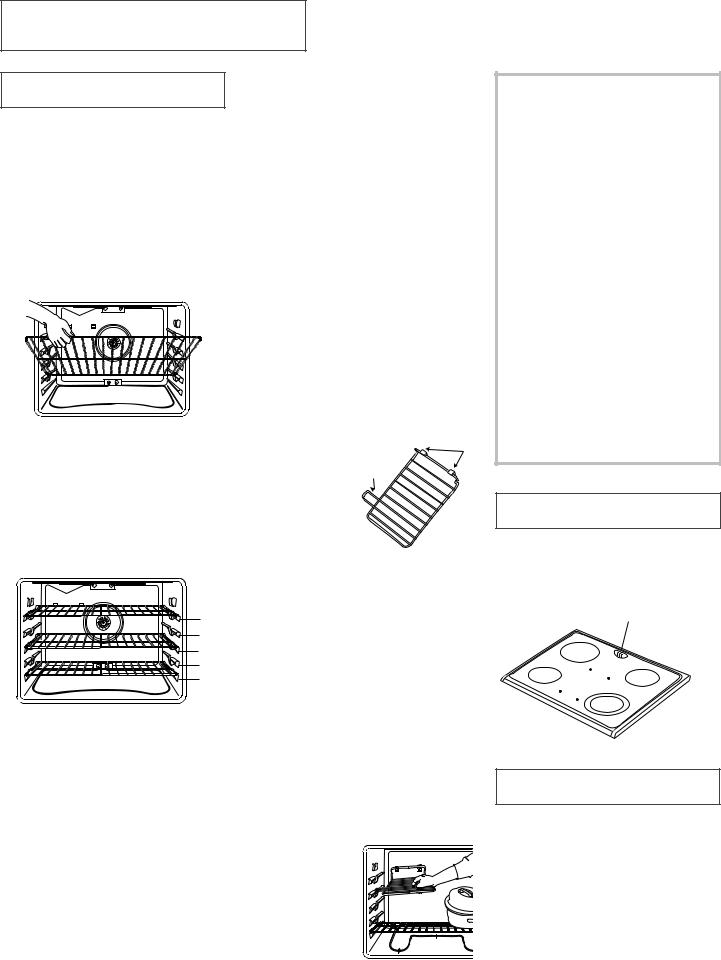
OVEN COOKING, CONT.
OVEN RACKS
The oven has two racks (three racks if convection). All racks are designed with a lock-stop edge.
TO REMOVE OVEN RACKS:
Pull rack straight out until it stops at the lock-stop position; lift up on the front of the rack and pull out.
TO REPLACE OVEN RACKS:
Place rack on the rack support in the oven; tilt the front end up slightly; slide rack back until it clears the lock-stop position; lower front and slide back into the oven.
RACK 2:
Use for roasting small cuts of meat, casseroles, baking loaves of bread, bundt cakes or custard pies, and two-rack baking.
RACK 1:
Use for roasting large cuts of meat and poultry, frozen pies, dessert souffles or angel food cake, and two-rack baking.
MULTIPLE RACK COOKING:
Two rack: Use rack positions 2 and 4, or 1 and 4.
Three rack: (convection functions only, select models) Use rack positions 1, 3 and 5. See illustration.
HALF RACK
(SELECT MODELS) |
Tabs |
TOINSTALLIN Support |
|
OVEN: |
|
1.Always install half rack when oven
is cool. |
Front |
RACK POSITIONS
5
4
3
2
1
Three-rack Convection
Baking (Racks 1, 3 and 5)
RACK 5:
Use for toasting bread or broiling very thin foods.
RACK 4:
Use for two-rack baking and for broiling.
RACK 3:
Use for most baked goods on a cookie sheet or jelly roll pan, layer cakes, fruit pies, or frozen convenience foods, and for broiling.
2.Grasp top center of the half rack. Align the side arm support between the top fourth and fifth oven rack guides. Insert the two tabs on the back frame of the half rack into the slots on the upper left rear of the oven wall.
3.Push firmly on the top surface of the half rack until the tabs slide into the slots and the half rack side arm support rests on the fourth oven rack guide.
4.Check for proper installation by placing your hand on the top surface of the half rack and pressing down firmly.
TO REMOVE FROM THE OVEN:
When the oven is cool, grasp the top center ofthe halfrack and pull upward until the back tabs on the rack slide out of the oven back slots.
NOTES:
•Do not use cookware that extends beyond edge of rack.
•For best results, allow two inches between the pan placed on the rack and the oven side wall.
•When opening the oven door, allow steam and hot air to escape before reaching into the oven to remove food.
•Use caution when removing items from the half rack to avoid burns.
•Carefully remove items from the lower rack to avoid disturbing the half rack.
•If not included with your range, contact your Jenn-Air dealer for the HALFRACK Accessory Kit or call 1-800-688-8408.
OVEN VENT
When the oven is in use, the vent and surrounding area become hot enough to cause burns. NEVER block the vent opening.
OVEN VENT LOCATION
COOLING FAN
The cooling fan will automatically turn on during cleaning, broiling and some baking operations. It is used to keep internal parts on the control panel cool. The fan will automatically turn off when parts have cooled. The fan may continue to operate after the oven has been turned off. This is normal.
13

CARE & CLEANING
CLEAN PAD
Use to set a self-clean cycle or a delayed self-clean cycle. One press of the Clean pad sets up an immediate clean cycle. A second press of the Clean pad sets up a delayed clean cycle.
•Clean oven frame, door
frame (area out-
side of gasket)
and around the opening in the
door gasket with a nonabrasive cleaner such as Bon Ami*. These areas are not exposed to cleaning temperatures.
•Remove oven racks. If racks are left in during a clean cycle, it may impair function and they will discolor. Turn off the oven light and close door.
* Brand names for cleaning products are registered trademarks of the respective manufacturers.
TO SET FOR IMMEDIATE START:
1.Press Clean pad once.
2.Press the Auto Set pad for 3 hours of cleaning time, press again for 4 hours and again if 2 hours of clean time is desired.
3.CLEANING and LOC plus the clean time will appear in the display.
4.When the clean cycle is complete, CLEANED will be displayed. LOC will remain on until the oven has cooled (approx. 1 hour).
5.When the oven is cool, LOC will no longer be displayed and the door may be opened.
6.Wipe out the oven interior with a damp cloth. If soil remains it indicates the cycle was not long enough.
TO CANCEL SELF-CLEAN:
1.Press Cancel pad.
2.If LOC is NOT displayed, open oven door. If LOC is displayed, allow oven to cool.
TO SET FOR DELAY START:
1.Press Clean pad twice.
2.Press the Auto Set pad to program a 2-hour delay. Each additional press of
Auto Set will add 2-hours up to a total delay of eight hours from the current time.
3.The start time and the time of day will be displayed during the delay period.
4.At the end of the delay period, CLEANING, LOC and the clean time will appear in the display.
5.Follow steps 4-6 in preceding section.
NOTES:
• |
To prevent damage to oven door, do |
|
touching cooktop, door, window or |
|
not attempt to open oven door when |
|
oven vent area during a clean cycle. |
|
the LOC indicator word is displayed. |
• A cooling fan will automatically turn on |
|
|
|
||
• Duringthecleaningprocess,thekitchen |
|
during cleaning. If it does not operate, |
|
|
should be well ventilated to help elimi- |
|
contact an authorized servicer. |
|
nate normal odors associated with |
• |
Wipe up sugary and acidic spillovers |
|
cleaning. Odors will lessen with use. |
||
|
|
such as sweet potatoes, tomato or |
|
|
|
|
|
• |
It is normal for flare-ups, smoking or |
|
milk-based sauces prior to a self-clean |
|
flaming to occur during cleaning if the |
|
cycle. Porcelain enamel is acid resis- |
|
oven is heavily soiled. It is better to |
|
tant, not acid proof and may discolor |
|
clean the oven regularly rather than to |
|
if spills are not wiped up before a self- |
|
wait until there is a heavy buildup of |
|
clean cycle. |
|
soil. |
• |
A white discoloration may appear af- |
|
|
||
• Wipe up excess grease or spillovers to |
|
ter cleaning if acidic or sugary foods |
|
|
prevent flare-ups. For ease in cleaning, |
|
are not wiped up before the clean |
|
the bake element in the oven can be |
|
cycle. This discoloration is normal and |
|
lifted slightly (1 inch). |
|
will NOT affect performance. |
• |
It is normal for parts of the range to |
|
|
|
become hot during a clean cycle. Avoid |
|
|
14

CARE & CLEANING, CONT.
CLEANING PROCEDURES
 CAUTION
CAUTION
•Be sure appliance is off and all parts are cool before handling or cleaning. This is to avoid damage and possible burns.
•To prevent staining or discoloration, clean appliance after each use.
•If a part is removed, be sure it is correctly replaced.
BROILER PAN AND INSERT
•Place soapy cloth over insert and pan; let soak to loosen soil.
•Wash in warm soapy water. Use scouring pad to remove stubborn soil.
•Broiler pan and insert can be cleaned in dishwasher.
CLOCK AND CONTROL
PAD AREA
•To activate “Control Lock” for cleaning, see page 12.
•Wipe with a damp cloth and dry.
•Glass cleaners may be used if sprayed on a cloth first. DO NOT spray directly on control pad and display area.
CONTROL PANEL
•Wipe with damp cloth.
•For stubborn soil, use mildly abrasive cleaning agents such as Bon Ami*. Do NOT use abrasive cleaners such as steel wool pads or oven cleaners. These products will permanently damage the surface.
CONTROL KNOBS
•Remove knobs in the OFF position by pulling forward.
•Wash, rinse and dry. Do not use abrasive cleaning agents as they may scratch the finish.
•Turn on each element to be sure the knobs have been correctly replaced.
COOKTOP – GLASS-CERAMIC
Never use oven cleaners, chlorine bleach, ammonia or glass cleaners with ammonia. NOTE: Call an authorized servicer if the glass-ceramic top should crack, break or if metal or aluminum foil should melt on the cooktop.
•Allow the cooktop to cool before cleaning.
•General – Clean cooktop after each use, or when needed, with a damp paper towel and Cooktop Cleaning Creme (Part No. 20000001)**. Then, buff with a clean dry cloth.
NOTE: Permanent stains will develop if soil is allowed to cook on by repeatedly using the cooktop when soiled.
•Heavy Soils or Metal Marks –
Dampen a “scratchless” or “never scratch” scrubber sponge. Apply Cooktop Cleaning Creme* (Part No. 20000001)** and scrub to remove as much soil as possible. Apply a thin layer of the creme over the soil, cover with a damp paper towel and let stand 30 to 45 minutes (2-3 hours for very heavy soil). Keep moist by covering the paper towel with plastic wrap. Scrub again, then buff with a clean dry cloth.
NOTE: Only use a CLEAN, DAMP “scratchless” pad that is safe for non-stick cookware. The pattern and glass will be damaged if the pad is not damp, if the pad is soiled, or if another type of pad is used.
•Burned-on or Crusty Soils – Scrub with a “scratchless” or “never scratch” scouring pad and Cooktop Cleaning Creme*. Hold a
razor blade scraper at
30° angle scrape any remain ing soil. Then, clean as described above.
NOTE: Do not use the razor blade for daily cleaning as it may wear the pattern on the glass.
•Melted Sugar or Plastic – Immediately turn element to LOW and scrape sugar or plastic from hot surface to a cool area. Then turn element OFF and allow to cool. Clean residue with razor blade scraper and Cooktop Cleaning Creme*.
COOKTOP TRIM
•General Cleaning/Heavy Soils - See directions for glass-ceramic cooking area. Do not use razor blade on cooktop trim.
•For Difficult Stains, Minor Discolorations or Yellowing - Gently scour using a mild-abrasive cleaner such as Soft Scrub* and a green Scotch-Brite* pad.
(Do not use Scotch-Brite pad on glassceramic surface.) Rinse and dry. Follow with HOPE’S COUNTERTOP POLISH** to enhance the cooktop’s color and shine. Follow package directions.
•To Protect and Renew the Surface Shine - Use HOPE’S COUNTERTOP POLISH**. Follow package directions.
DOOR HANDLE – PLASTIC
FINISHES
•When cool, clean with soap and water, rinse and dry.
•Use a glass cleaner and a soft cloth.
NOTE: Never use oven cleaners, abrasive or caustic liquid or powdered cleansers on plastic finishes. These cleaning agents will scratch or mar finish.
NOTE: To prevent staining or discoloration, wipe up fat, grease or acid (tomato, lemon, vinegar, milk, fruit juice, marinade) immediately with a dry paper towel.
OVEN WINDOW & DOOR –
GLASS
•Avoid using excessive amounts of water which may seep under or behind glass causing staining.
15
•Wash with soap and water. Rinse with clear water and dry. Glass cleaner can be used if sprayed on a cloth first.
•Do not use abrasive materials such as scouring pads, steel wool or powdered cleaners as they will scratch glass.
OVEN INTERIORS
•Follow instructions on page 14 to set a self-clean cycle.
OVEN RACKS
•Clean with soapy water.
•Remove stubborn soil with cleansing powder or soap-filled scouring pad. Rinse and dry.
•If over time, racks do not slide out easily, wipe the rack edge and rack support with a small amount of vegetable oil to restore ease of movement, then wipe off excess oil. Likewise, place one drop of vegetable oil on rack guides.
NOTE: Remove oven racks during a clean cycle. If racks are left in the oven, it may impair function and they will discolor.
STAINLESS STEEL
(SELECT MODELS)
•DO NOT USE ANY CLEANING PRODUCT CONTAINING CHLORINE BLEACH.
•ALWAYS WIPE WITH THE GRAIN WHEN CLEANING.
•Daily Cleaning/Light Soil –– Wipe with one of the following - soapy water, white vinegar/water solution, Formula 409 Glass and Surface Cleaner* or a similar glass cleaner - using a sponge or soft cloth. Rinse and dry. To polish and help prevent fingerprints, follow with Stainless Steel Magic Spray (Jenn-Air Model A912, Part No. 20000008)**.
•Moderate/Heavy Soil –– Wipe with one of the following - Bon Ami, Smart Cleanser, or Soft Scrub* - using a damp sponge or soft cloth. Rinse and dry. Stubborn soils may be removed with a damp Scotch-Brite* pad; rub evenly with the grain. Rinse and Dry. To restore luster and remove streaks, follow with Stainless Steel Magic Spray*.
•Discoloration –– Using a damp sponge or soft cloth, wipe with Cameo Stainless Steel Cleaner*. Rinse immediately and dry. To remove streaks and restore luster, follow with Stainless Steel Magic Spray*.
STORAGE DRAWER –
PAINTED ENAMEL
•When cool, wash with warm soapy water, rinse and dry. Never wipe a warm or hot surface with a damp cloth as this may damage the surface and may cause a steam burn.
•For stubborn soil, use mildly abrasive cleaning agents such as baking soda paste or Bon Ami.* Do not use abrasive, caustic or harsh cleaning agents such as steel wool pads or oven cleaners. These products will scratch or permanently damage the surface.
NOTE: Use dry towel or cloth to wipe up spills, especially acid or sugary spills. Surface may discolor or dull if soil is not immediately removed. This is especially important for white surfaces.
* Brand names for cleaning products are registered trademarks of the respective manufacturers.
** To order direct, call 1-800-688-8408.
16
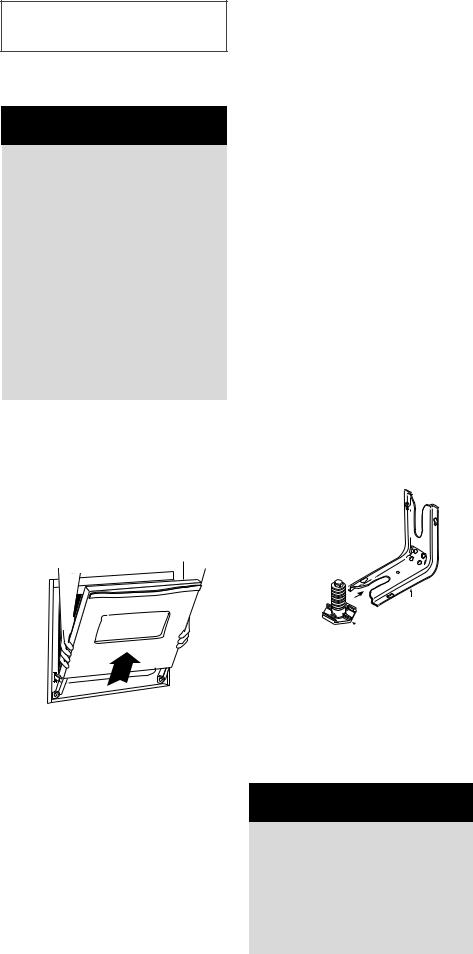
MAINTENANCE
OVEN DOOR
 CAUTION
CAUTION
•NEVER place excessive weight on or stand on an open oven door. This could cause the range to tip over, break the door, or injure the user.
•NEVER attempt to open or close door or operate oven until door is properly replaced.
•NEVER place fingers between hinge and front oven frame. Hinge arms are spring mounted. If accidentally hit, the hinge will slam shut against oven frame and could injure your fingers.
TO REMOVE:
1.When cool, open the oven door to the broil stop position (opened about four inches).
2.Grasp door at each side. Do not use the door handle to lift door.
3.Lift up evenly until door clears hinge
arms.
TO REPLACE:
1.Grasp door at each side.
2.Align slots in the door with the hinge arms on the range.
3.Slide the door down onto the hinge arms until the door is completely seated on the hinges. Push down on the top corners of the door to completely seat door on hinges. Door should not appear crooked.
NOTE: The oven door on a new range may feel “spongy” when it is closed. This is normal and will decrease with use.
OVEN WINDOW
TO PROTECT THE OVEN DOOR WINDOW:
1.Do not hit the glass with pots, pans, furniture, toys, or other objects.
2Do not close the oven door until the oven racks are in place.
Scratching, hitting, jarring or stressing the glass may weaken its structure causing an increased risk of breakage at a later date.
LEVELING LEGS
• Be sure the anti-tip bracket secures one of the rear leveling legs to the floor. This bracket prevents the range from accidentally tipping.
The range should be leveled when installed. If the range is not level, turn the plastic leveling legs, located at each corner of the range, until range is level.
ANTI-TIP-TIPBRACKET
 LEVELING LEG
LEVELING LEG
LEVELING LEG
OVEN LIGHT
To assure the proper replacement bulb is used, order bulb from Maytag Customer Service. Call 1-800-688-8408, ask for part number 74004458 - halogen bulb.
 CAUTION
CAUTION
•Disconnect power to range before replacing light bulb.
•Allow oven to cool before replacing light bulb.
•Make sure bulb cover and bulb are cool before touching.
TO REPLACE OVEN LIGHT BULB:
1.When oven is cool, use fingertips to grasp edge of bulb cover. Pull out and remove.
2.Carefully remove old bulb by pulling straight out of ceramic base.
3.To avoid damaging or decreasing the life of the new bulb, do not touch the bulb with bare hands or fingers. Hold with a cloth or paper towel. Push new bulb prongs straight into small holes of ceramic base.
4.Replace bulb cover by snapping into place.
5.Reconnect power to the range. Reset clock.
STORAGE DRAWER
The storage drawer at the bottom of the range is safe and convenient for storing metal and glass cookware. DO NOT store plastic, paperware, food or flammable material in this drawer. Remove drawer to clean under range.
To remove: Empty drawer then pull out to the first stop position. Lift up front of drawer and pull to the second stop position. Grasp sides and lift up and out to remove drawer.
To replace: Fit the ends of the drawer glides onto the rails. Lift up drawer front and gently push in to first stop position. Lift up and continue to slide drawer to the closed position.
17
